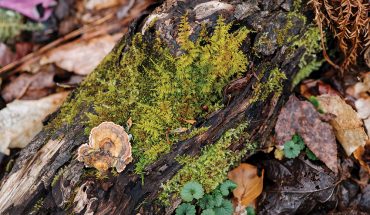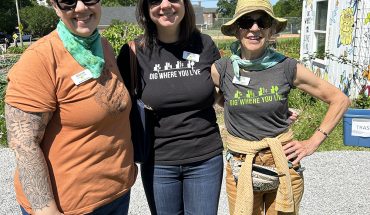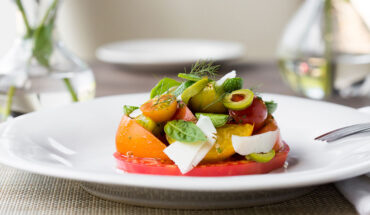A movement toward locally-grown, seasonal flowers has created a new, women-led community of farmers in the Triangle.
by Jessie Ammons Rumbley | photography by Liz Condo
“Flowers connect people in so many ways,” says Stephanie Hall of Sassafras Fork Farm in Rougemont. “They connect us to the simple beauty nature offers, they connect us to memories and our past, they connect us to joy and happiness, they connect us to seasonality and natural rhythms, and they connect us together through sharing these soul-soothing natural beauties.”
Hall is part of the Triangle’s expanding industry of growers and florists invested in producing seasonal, unique blooms like maroon lysimachia, black and lavender anemones and hot-pink ranunculus. With firm roots in Southern gardening, the women who lead these farms find joy in harvesting the art of the field for an increasingly captive audience, from market shoppers to wedding and event planners.
Roots in Southern gardening
Full-time flower-growing is not a hobby—it comes with all the same hard work as farming. But of the more than one dozen Triangle farmers focusing on flowers, many of them credit at least some of their interest to household gardens. “Gardening, in many Southern families, is a bit of a way of life,” says Kelly Morrison of Color Fields in Durham. “My grandmother and my aunts were always splitting perennials and giving them to each other.” Morrison started her own farm in 2014, where she grows around 40 flower varieties on about an acre of land, mostly for weddings and wholesale orders.
“Growing up, my father always had a really beautiful garden in our yard, and I know that’s part of what led me to this profession,” says Alice White of Bluebird Meadows, the 30-acre farm in Hurdle Mills where she grows more than 100 flower varieties, mostly to sell at the farmers market and through flower subscriptions.
Gardening likewise inspires florists, including the artful Raleigh design studio, Wylde. “When we design with cut flowers, we think about all of those senses of movement and light and form that you observe in the garden, in the meadow, in the woods,” says Hannah Ross Clarke of Wylde. Clarke has a background in sustainable agriculture and today maintains a small garden plot near downtown Raleigh, where she grows unusual varieties to complement the other local blooms that she and business partner Nikelle Orellana-Reyes include in their arrangements.
Even on a larger scale, the spirit of gardening is alive and well in these farms. During her early vegetable farming days, White “fell in love with flowers and the color that they are able to convey, that living color,” she says. Flowers are “little bundles of beauty” in the field, agrees Hall, who grows flowers on two of the 150 acres at Sassafras Fork Farm.
Growing them also makes good business sense, especially for small farmers. Cut flowers yield a higher profit margin than fruits and vegetables, Morrison says, which enables farmers to make a living and, hopefully, own their farmland (many farmers rent). And in turn, financial stability means farmers are more likely to prioritize sustainable practices and thoughtful production, she says. “Growing a higher-value crop, like flowers, allows a farmer to be a better steward.”
Responding to the seasons
The Triangle’s flower scene has evolved tremendously in the last decade. White was one of the first local flower farmers when she started her farm in 2006. At the time, there were a few other celebrated longtime local growers—including Peregrine Farm in Graham and Wild Hare Farm in Cedar Grove—but not much of an industry beyond farmers markets. In the early years, White focused on vegetables more than flowers, responding to the demand of customers at her home market, Durham Farmers’ Market. Since then, what’s called the “slow flower” movement has taken off across the nation, promoting American-grown flowers, especially those sourced locally, seasonally and sustainably.
In 2014, Durham resident Maggie Smith opened Pine State Flowers, the Triangle’s first flower shop to specialize in locally grown flowers. Not long after, Orellana-Reyes founded Wylde, creating artful, seasonally inspired florals. Simultaneously, wedding trends favored looser, more organically shaped bouquets. “It’s like when local food was just emerging in restaurants,” recalls Morrison. “You see all this potential. It was the same with flowers.”
Among the Triangle flower-farming community, the potential was—and is—exciting. Hall recalls talking to Smith about six years ago, just before Pine State Flowers opened. “I remember thinking, ‘oh my gosh, it’s coming, the local flower movement is really starting here,’” says Hall. It was one of the first moments that bolstered her to focus exclusively on flowers. “I battled with giving up growing produce, just because food is a necessity whereas flowers are, well, not,” she says. But Hall reminded herself that locally grown blooms do have a place. “The neat thing about local flowers is that customers can get varieties they normally wouldn’t be able to find,” she says, noting that even in more common flowers like tulips, the locally-grown versions offer stronger scents and more color variation.
White says her farm priorities shifted gradually, as well. “Flowers are most certainly my passion and my drive,” she says. But in the beginning, “I felt like a market table would bring in more people, and the farm would be more successful with vegetables.” Sixteen years later, Bluebird Meadows now fills about 60 percent of its field space with native blooms. “I’ve come to really love and admire native plants. Beyond being best-suited to grow in our area, they bring in all kinds of pollinators,” she says. Likewise, Hall’s Sassafras Fork, which she owns and runs with her parents and husband, today forgoes vegetables to focus on meat and flowers, “the petals and the pasture.”
To reflect the evolving industry, Morrison helped found Piedmont Wholesale, a co-op of ten flower farms that offers a one-stop-shop for local wholesalers, such as Orellana-Reyes and Clarke of Wylde, as well as limited public shopping hours and deliveries. While the success of mainstays like Bluebird Meadows relies on farmers markets, “the movement to sell to florists has grown,” Morrison says, especially among newer and smaller farmers. “We want to create something that’s really beautiful by showcasing what’s in season and highlighting the beauty from local farmers,” says Orellana-Reyes.
A new farming community
Whether growing for market, for brides, for florists, or for all of the above, there is a sense of camaraderie among the flower farmers. “We’re all working together,” Hall says. If she gets a request for a specific bloom, for instance, and she can’t accommodate, she’s quick to recommend other local farms in return. Same goes at market; when shoppers buy eggs, beef, and flowers from Hall and her dad at South Durham Farmers’ Market and want veggies to round out the haul, Hall and team are happy to share their favorite growers. Slow flowers, after all, aren’t that different from slow food. “Flower production is a crop just like any other crop,” Morrison says.
Yes, technically it may be just another crop—but visiting a North Carolina flower farm, it would be hard to agree. When you step onto any of these larger-than-life flower patches, it’s an experience unlike any other: the fields are blanketed in color, the air is filled with perfume and butterflies and bees bounce from bloom to bloom. Farming can be tough, says Morrison of Color Fields, but it’s worth it. “I get joy from flowers,” she says. “Growing them calms me.”







